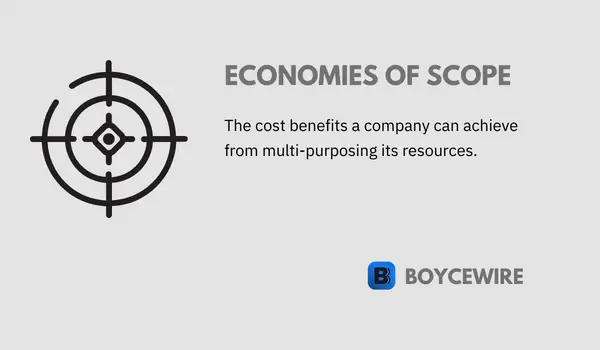Economies of Scope: Definition, Pros, Cons & Example

What is Economies of Scope
Economies of scope is the cost benefit that a company achieves when it maximises its resources by using it for multiple purposes. This may come through producing a number of different goods and benefiting from synergies from different parts of its business.
In other words, it’s the efficiencies that a firm gains by fully utilitizing its resources. This includes its equipment, land, labor, distribution channels, or marketing campaigns.
For instance, a manufacturer may use its factory to produce motor vehicles, but there is only demand for it to run at 50% capacity. By introducing other models, it may be able to increase demand so that it is able to run at full capacity. This reduces costs by fully utilising the rent, labor, and utilities.
The same manufacturer may also benefit from savings within the supply chain, logistics, and marketing. It can use its marketing campaign to appeal to both consumers of its product lines. This then reduces the per unit costs of its advertisements.
Key Points
- Economies of scope is the cost savings that a firm gains from producing multiple goods together.
- A firm can benefit from lower costs in areas such as production, distribution, marketing, and labor.
- By producing two or more goods together, it is able to benefit from lower fixed costs which are spread out across a greater array of goods.
- It can lead to greater competitiveness as it leads to product diversification and lower unit costs. So not only can it produces goods at a lower price, but also offer more choice.
Types of Economies of Scope
There are three main types of economies of scope:
1. Marketing economies of scope
This refers to the cost savings that a firm achieves by deploying its marketing efforts across its goods or brands. For example, companies such as Walmart sell a wide variety of own-brand goods. However, rather than market each one individually, it is able to benefit from cost savings by advertising the firms brand as a whole.
Companies such as Walmart are able to use their customer databases and help target specific brands. For instance, if a consumer is purchasing a lot of baby goods, they may offer a voucher for nappies. Yet it is able to utilise the firms wider array of goods to help develop this customer base it can target with other goods.
2. Production economies of scope
These are cost savings a firm can make by producing multiple goods using the same raw materials and production processes.
By producing multiple goods, it can benefit from lower costs in production facilities, equipment, labor, and raw materials. For instance, by offering more goods, a retailer may be able to fully stock their store to make it more appealing. Alternatively, a manufacturer may use the same processes to other goods it makes.
In turn, this can help reduce the per unit costs of producing various goods. By leveraging its existing resources, it is able to produce additional goods at a lower cost.
3. Technical or technological economies of scope
Refers to how the use of technology can be expanded throughout the scope of the company to achieve cost efficiencies.
For instance, a firm may benefit from a technological advancement which helps increase the speed by which it can deliver to customers. It may also develop a technology which improves efficiency and therefore lowers its per unit costs. However, the wider the scope of the firm, the greater the advancement reduces its costs.
Formula for Economies of Scope
We can calculate economies of scope using the formula below:

To calculate the cost of Product A, the firm needs to take into consideration all the associated costs. These include any fixed costs such as rent, equipment, and labor – as well as variable costs such as utilities and raw materials.
We then need to do the same with Product B. However, we need to do these calculations in isolation. So just because a fixed cost is used for Product A, we cannot discount it as a cost for Product B.
Once both these figures are calculated, we need to take the total cost of producing Product A and B. It will be noted that there are some overlaps which will account for some of the synergies and cost savings. For instance, the cost of renting one factory may be enough to produce both Product A and B.
For example, if we take an example of Company A that produces Products A and B. The total cost of producing 5,000 units of Product A is $20,000. The total cost of producing 5,000 units of Product B is $16,000. So the total cost of producing a total of 10,000 units separately is $36,000. However, once they are produced together, the total cost is $30,000.
Therefore, the economies of scope achieved by the company are:
$20,000 + $16,000 – $30,000 / $30,000 = $0.20
The positive result shows that the company is making sufficient cost savings from producing both together. However, if the result was negative, it would show that it would be highly inefficient to produce these two products at the same time.
Advantages of Economies of Scope
Here are some advantages of economies of scope:
1. Cost savings
By achieving economies of scope, the firm is able to benefit from lower per unit costs. Lower costs in areas such as production, marketing, and distribution all allow the firm to charge lower prices to consumers.
By producing a variety of goods, a business can spread out its fixed costs, thereby reducing its per unit cost. Consumers can benefit from lower prices, or producers will benefit from higher profit margins.
2. Increased efficiency
Economies of scope help to improve the efficiency of the firm. By providing a variety of goods, departments within the firm can share resources such as facilities, equipment, and personnel between products and services.
In turn, the firm becomes more efficient as it can fully utilise its resources. For instance, a marketing employee can create one advertisement for multiple products instead of several ads for different goods.
3. Diversification
By producing a range of products or services, a firm can diversify its revenue streams and reduce its dependence on any one product or market, which can help to mitigate risks associated with changes in consumer demand or economic conditions.
4. Increased bargaining power
By producing a range of products or services, a firm can increase its bargaining power with suppliers and customers. This is because the firm can negotiate better deals for bulk purchases and can offer customers a wider range of products or services, which can improve customer loyalty and retention.
5. Competitive advantage
Overall, economies of scope can provide a firm with a competitive advantage over its rivals, as it can offer a wider range of products or services at a lower cost, while also improving operational efficiency and diversifying its revenue streams. This can help to attract new customers and retain existing ones, while also improving profitability and shareholder value.
Disadvantages of Economies of Scope
Here are some disadvantages of economies of scope:
1. Complexity
Economies of scope can make a firm’s operations more complex and difficult to manage. Producing multiple products or services may require different skills, technologies, and resources, which can make it harder to coordinate and control the firm’s operations.
2. Diseconomies of scale
While economies of scope can lead to cost savings, they can also lead to diseconomies of scale, where the increased complexity and inefficiencies associated with producing multiple products or services offset the benefits of economies of scope.
3. Risk
Diversification through economies of scope can also increase a firm’s risk exposure. Producing multiple products or services means that the firm is more susceptible to changes in consumer demand, competition, and economic conditions, which can reduce its profitability and financial stability.
4. Strategic focus
Pursuing economies of scope may divert a firm’s attention away from its core competencies and strategic focus. Focusing on too many products or services can dilute a firm’s brand and reduce its ability to differentiate itself from competitors.
5. Limited benefits
The benefits of economies of scope may be limited in some cases, particularly if the synergies between different products or services are weak or if the costs of producing multiple products or services outweigh the benefits.
Overall, while economies of scope can provide firms with cost savings, increased efficiency, and a competitive advantage, they also come with risks and challenges that need to be carefully managed.
Economies of Scope Example
Here is an example of economies of scope:
Let’s say a company produces both ice cream and frozen yogurt. The ice cream requires a certain production process, such as churning, flavoring, and packaging. The frozen yogurt requires a similar process, but with some modifications, such as adding live cultures to the mix.
Without economies of scope, the company would have to invest in separate production facilities, staff, and equipment for each product line. However, by producing both ice cream and frozen yogurt, the company can leverage its production processes, staff, and equipment to reduce its costs. For example, the company could use the same churning and packaging equipment for both ice cream and frozen yogurt, and could train its staff to handle both product lines. This would reduce the per-unit cost of production for both ice cream and frozen yogurt, as the fixed costs associated with production would be spread over a larger volume of output.
In addition, the company could also leverage its marketing channels and campaigns for both ice cream and frozen yogurt, such as using the same advertising and promotional materials for both products. This would reduce the company’s marketing costs and increase its efficiency in reaching customers.
Overall, by producing both ice cream and frozen yogurt together, the company can achieve economies of scope that reduce its costs, increase its efficiency, and provide a competitive advantage
Economies of Scope vs Economies of Scale
Economies of scope and economies of scale are both concepts related to cost savings in production, but they refer to different aspects of cost efficiency.
Economies of scale refer to the cost advantages that result from increasing the scale or size of production, such as the ability to spread fixed costs over a larger volume of output.
For example, a company that increases its production volume of a single product may be able to reduce its per-unit cost of production by taking advantage of bulk discounts on raw materials, reducing the cost of machinery and equipment per unit, and increasing specialization and division of labor among its workers.
On the other hand, economies of scope refer to the cost advantages that result from producing multiple products or services together. For example, a company that produces both ice cream and frozen yogurt can use the same production equipment, such as a churn and a freezer, for both products.
This reduces the per-unit cost of production for both ice cream and frozen yogurt as the fixed costs associated with production are spread over a larger volume of output. Additionally, economies of scope may also lead to improved marketing efficiencies, as a company can use the same marketing channels and promotional materials for multiple products.
In summary, economies of scale refer to cost savings due to increased production volume, while economies of scope refer to cost savings due to producing multiple products or services together. Both concepts are important for firms to consider when trying to increase their cost efficiency and remain competitive in the marketplace.
FAQs
Economies of scope refer to the cost savings that a firm can achieve by producing multiple products or services together, while economies of scale refer to the cost savings that a firm can achieve by increasing the scale of its production.
A company can achieve economies of scope by sharing resources such as production facilities, distribution channels, and marketing efforts across multiple products or services. This can result in lower production costs, greater efficiency, and increased competitiveness.
Examples of companies that have achieved economies of scope include Amazon, which has leveraged its expertise in logistics to offer a wide range of products and services, and Marriott International, which offers a range of hotel brands under one company.
Economies of scope can be achieved in many industries, but they are particularly important in industries such as healthcare, where companies can achieve cost savings by offering a range of services under one roof.
About Paul
Paul Boyce is an economics editor with over 10 years experience in the industry. Currently working as a consultant within the financial services sector, Paul is the CEO and chief editor of BoyceWire. He has written publications for FEE, the Mises Institute, and many others.

Further Reading
 Autarky Definition and Examples - Autarky is a self-sufficient economic state without international trade, but can limit growth due to higher costs, limited access to…
Autarky Definition and Examples - Autarky is a self-sufficient economic state without international trade, but can limit growth due to higher costs, limited access to…  Availability Heuristic: Definition & Examples - The availability heuristic is where recent memories are weighted more significantly.
Availability Heuristic: Definition & Examples - The availability heuristic is where recent memories are weighted more significantly.  Corporate Social Responsibility (CSR): Definition & Examples - Corporate Social Responsibility (CSR) is a type of corporate strategy that looks at how the business can better society as…
Corporate Social Responsibility (CSR): Definition & Examples - Corporate Social Responsibility (CSR) is a type of corporate strategy that looks at how the business can better society as… 